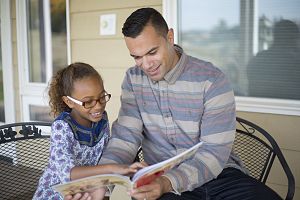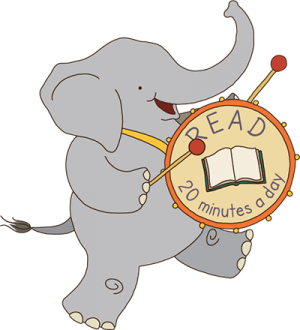End of Year Goals in Reading for Third Graders
Tertiary Class Reading Success Matters
Becoming a potent reader begins at birth. The cornerstones of reading success - language, cognition, and curiosity - should be cultivated from infancy, and in every setting.
Nonie K. Lesaux, Ph.D.
Turning the Folio
Reading is essential for learning
Children from all walks of life must acquire to read proficiently. Reading is the nigh crucial academic skill considering it is the foundation for learning. Through 3rd class children are learning to read; after third grade students read to learn. But only ane-in-3 students read proficiently by that point.
Without a strong foundation in reading, children are left backside at the beginning of their educational activity. They lag in every class, year after year because more than 85 percent of the curriculum is taught past reading. And by the terminate of third grade, 74 percentage of struggling readers won't ever catch up. In fact, one of the most important predictors of graduating from high school is reading proficiently by the end of third grade.

Reading issues are difficult to fix but easy to preclude
Reading together twenty minutes every day teaches most school readiness skills (e.g., vocabulary, counting, colors, social skills, etc.). The simple act of reading with a child every day has significant boosted benefits including:
- Increases the number of children acquiring the essential early on literacy skills required for inbound kindergarten prepared and eager for school.
- Develops socially and emotionally confident children who accept strong bonds and are at pace with their peers.
- Reduces the schoolhouse accomplishment gap and lowers remediation expenses for K-12 students by helping children start and stay at course level.
- Empowers parents and caregivers to become their child's first and most influential teachers.

90% Reading Goal
The Children'due south Reading Foundation encourages school districts and communities to prefer a 90 percentage reading goal. This goal means 90 percent of third graders will read on or in a higher place grade level by the terminate of the school year. By adopting this goal, illiteracy can exist eliminated.
This is not an piece of cake goal, but it can exist done. Achieving this goal requires a long-term committed effort, and a systematic realignment of school assessments, curriculum, instruction time, reporting, and a shift of bachelor resources.
Schoolhouse districts nationwide have adopted this goal, and achieved information technology! This is how The Children's Reading Foundation came to exist, formed by a grouping of community stakeholders with the Kennewick School District (Washington) to ensure 90 percent of the commune's third graders read proficiently.
When Kennewick School Commune set this goal in 1996, only 55 percent of its third graders were reading proficiently. Information technology took 10 years to accomplish this goal, simply they did it. There is non one thing that allows a school district to reach the 90 percent reading goal; it takes several:
- The school board and superintendent to set a clear, measurable goal.
- A solid, accurate system for measuring reading ability.
- A willingness to be absolutely truthful with themselves and their community well-nigh how many students are entering fourth course below proficient. A willingness to talk frankly about the public's reading expectations and the bodily reading performance past third grade.
- A specific plan identifying the strategies and recognizing resources and priorities will need to be aligned accordingly.
- Flexibility in approaches and curriculums.
- Involve parents and the community in creating a social norm to read with a kid for 20 minutes every day.
Whatsoever reading goal your schoolhouse commune sets, building a constituency for change and improvement in public schools is a circuitous, frequently challenging process, though a vital one to the success of the school organization, its students, and the customs. The imperative for educators – school boards, superintendents, principals, and teachers – is to develop ways of engaging, non merely parents and community members but besides business concern leaders, political leaders, and media representatives. It requires a commitment to inclusiveness, consensus, and meaningful change geared toward raising student achievement.
The details and specifics of how the Kennewick School District achieved its 90 percent goal can be constitute in the book, "The xc% Reading Goal." This book can be purchased from the Products & Resources folio.
Additional Resource
Prepare! for Reading - 101 Books Brochure.pdf
Gear up! for Reading - 101 Books Brochure - Spanish.pdf
Read With Your School Historic period Child Brochure.pdf
Read With Your School Historic period Child Brochure Castilian.pdf
Source: https://www.readingfoundation.org/third-grade-reading-matters
0 Response to "End of Year Goals in Reading for Third Graders"
Post a Comment